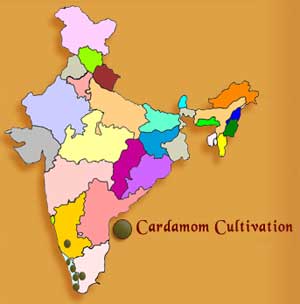CARDAMOM
Introduction
The cardamom of trade is the dehydrated seasoned fruit from the capsules of the cardamom plant and is often passed on as the “Queen of Spices” for the reason of its very pleasant fragrance and taste. Cardamom is a perennial, herbaceous, rhizomatous plant and is recognized by its small seed pods, triangular in cross-section and spindle-shaped, with a thin, papery, outer shell and small black seeds. Based on the natural history of panicles, three varieties of cardamom are recognized in Malabar with face down panicle, Mysore with straight panicle, and Vazhukka with semi straight panicle. Plants of average size are about 2 to 3 meters high with juvenile leaves on the dorsal side and fruits globose in the case of the Malabar, whereas plant robust highs 3 to 4 meters with leaves glabrous on both sides with ovoid shells in the case of Mysore variety. Vazhukka range is a mix of both the above in physical characteristics. It is the world's third most pricey spice by weight. Common Names
Elettaria cardamomum Maton is the scientific name of cardamom. It has common names in the languages of India. The common regional names of cardamom in different regions of India would be: In Hindi, Bengali it is called as Chhoti elachi. In Gujarati it is called as Elaychi. In Kannada as Yelakki. In Kashmiri as Aalbuduaal. In Malayalam as Elathari. In Marathi as Velchil. In Oriya as Alaichi. In Punjabi as Elaychi. In Sanskrit as Ela. In Tamil as Yelakkai or Elakkai. In Telugu as Yealak-Kayulu or Elakkayi. In Urdu as Ilaychi.
History
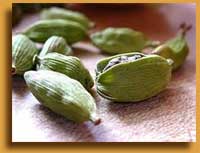
In the 11th century in India cardamom was incorporated in the list of elements for panchasugandha-thambula or 'five-fragrance betel chew' in the Manasollasa or Book of Splendor. It was also incorporated in recipes from the court of the Sultan of Mandu dating from about 1500. These recipes comprise of sherbets and rice dishes flavored with cardamom. Exact cardamom became an object of trade with South Asia in the last thousand years when Arab traders brought it into extensive use. Exports from the Malabar shore, close to where cardamoms grew untamed were portrayed by the Portuguese traveler Barbosa in 1524. By the time of Garcia DA Orta in 1563 the worldwide trade in cardamoms was finely urbanized. Kerala continued to dominate the cardamom trade until the colonial era. It was bought by the Raja's administrators and a few of it were sold to Muslim merchants while the most excellent quality was sold abroad. In the 19th century British settlement established cardamom as a secondary crop in coffee agricultural estate in further parts of India.
Habitat
Cardamom plants grow untamed in parts of the torrential rain forests of the Western Ghats in southern India. This area has been known as the Cardamom Hills, and in anticipation of just 200 years ago wild plants from these hills supplied the most of the world's supply of cardamom. The fruits have been sold and bought in India for at least 1000 years. Cardamom was known as the Queen of Spices, with black pepper being the King. The Leaves of the plant are dark green, long and sword-shaped. The underside is paler and may have a casing of tiny hairs. The Flowers of the plant are on a long flowering stalk which can grow to more than 1 m long. They are both male and female and are pale green. One of the petals is white and streaked with violet. The fruits of the plant are pale green to yellow in color and have elongated oval-shape. Each fruit has 3 cavity filled with small aromatic seeds, each about 3 mm long. The fruits and seeds dry to a straw-brown color and are widely used as flavoring.
Uses
All the forms of cardamom are used as flavoring agents in both food and drink, as cooking spices and as a medicine.
Cooking, Food and Drink
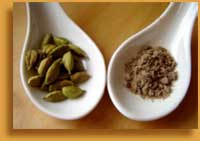
It is a widespread component in Indian cooking and is often used in baking in Nordic countries, such as in the Finnish sweet bread pulla or in the Scandinavian bread Julekake. In the Middle East, green cardamom dust is used as a spice for sugary dishes, as well as a conventional flavoring in coffee and tea. Cardamom pods are ground together with coffee beans to make a powdered mixture of the two, which is boiled with water to make coffee. Cardamom is used to some extent in savory dishes. In some Middle Eastern nations, coffee and cardamom are habitually grounded in a wooden mortar, a mihbaj, and cooked together in a skillet, a mehmas, over wood or gas, to create mixtures as much as 40% cardamom.
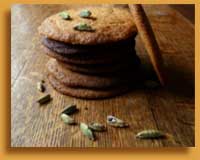
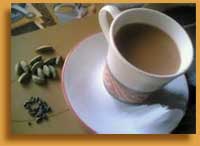
Medicine
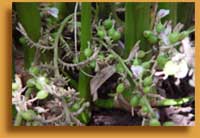
In Ayurvedic medicine cardamom is used to take care of disorders of the stomach and urinary system, asthma, bronchitis and heart tribulations. When assorted with neem and camphor, cardamom is used as a nasal preparation to take care of colds. A mixture of cardamom can be used as a gargle to alleviate sore throats, which has led to its use in cough sweets. The conventional uses of cardamom to take care of skin conditions have engrossed the attention of those developing plant-based cosmetics, particularly as it has been used conventionally to treat areas of the body that have red-pigmentation. It is often incorporated into soaps and hand creams.
Growing Cardamom
A low-growing, leafy hot plant, which grows on the forest floor in the wild. Cardamom can only be developed indoors in our country. Cardamoms have even green leaves on long stalks, which are spicily aromatic when bruised. The leaves don't scent the same as the seeds, but can be used to enfold around fish, rice or vegetables add flavor during cooking. The lengthy stalks are useful to tie the leaves jointly to make a neat parcel of food. The cardamom pods sold for food preparation are picked when immature so the seeds will not grow if you try to implant them. Cardamoms won't stay alive outdoors even in summer.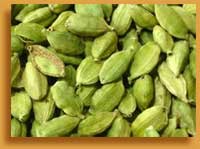
Cardamom Cultivation in India
